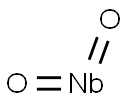Molybdenum(IV) oxide
Synonym(s):Molybdenum dioxide
- CAS NO.:18868-43-4
- Empirical Formula: MoO2
- Molecular Weight: 127.94
- MDL number: MFCD00014223
- EINECS: 242-637-9
- SAFETY DATA SHEET (SDS)
- Update Date: 2024-12-18 14:08:57

What is Molybdenum(IV) oxide?
Chemical properties
Lead-gray, nonvolatile powder. Dapproximately 6.4. Insoluble in hydrochloric acidand hydrogen fluoride and alkalies, sparingly solu-ble in sulfuric acid.
Physical properties
Molybdenum(IV) oxide can be prepared by several methods including controlled oxidation of Mo and controlled reduction of MoO3 with hydrogen. The pure oxide suitable for structure determination has been prepared by electrolysis of a polymolybdate (K2O5.MoO3) solution. Molybdenum(IV) oxide is insoluble in water: it is inert in solutions of nonoxidizing acids or bases, but is dissolved by oxidizing solutions. It dissociates to Mo and MoO3 at high temperatures (~ 1100°).
Crystalline MoO2 is violet or brown. Its deformed rutile structure consists of infinite chains of MoO6 octahedra sharing opposite edges along the chain direction with Mo-Mo distances alternately long (3.10 A) and short (2.50 A). It is diamagnetic and semiconducting ; metal-metal bonds are present. Some of its thermodynamic properties are as follows: G°f29% ~ 172.415 kcal/mole H°f29% -140.5 kcal/mole S°298 11.954 gibbs/mole.
The Uses of Molybdenum(IV) oxide
Molybdenum(IV) oxide is used to catalyze the dehydrogenation of alcohols. It is also used as an intermediates and processing aids. It finds application in the manufacture of molybdenum nano-wires.
The Uses of Molybdenum(IV) oxide
Molybdenum(IV) oxide (MoO2) is a transition metal oxide with good electrical conductivity due to the presence of delocalized electrons in its valence band. It is traditionally prepared by reducing MoO3 in dry hydrogen in the temperature range of 450-550°C.
MoO2 can be used in a variety of energy based applications such as an anode material in rechargeable lithium batteries and fuel flexible solid oxide fuel cells.It can also be used as a catalyst in hydrogen reforming processes.
Preparation
Molybdenum(IV) oxide is obtained by passing steam over red hot molybdenum:
Mo + 2H2O → MoO2 + 2H2
Alternatively, the oxide may be prepared by heating a molybdate salt, such as ammonium molybdate, with a reducing agent such as zinc. The dioxide also may be obtained along with other oxides of molybdenum when molybdenum metal is heated in air.
A brown-black suspension of MoO2 in hydrate form may be obtained by reducing a solution of ammonium molybdate with hydrogen in the presence of colloidal palladium.
General Description
Molybdenum(IV) oxide (MoO2) is a transition metal oxide with good electrical conductivity due to the presence of delocalized electrons in its valence band. It is traditionally prepared by reducing MoO3 in dry hydrogen in the temperature range of 450-550°C.
Hazard
Toxic material.
Safety Profile
Poison by subcutaneous route. Incandescent reaction with air. When heated to decomposition it emits toxic fumes of Mo.
Properties of Molybdenum(IV) oxide
| Melting point: | decomposes [JAN85] |
| Density | 6.47 g/mL at 25 °C (lit.) |
| solubility | insoluble in H2O, acid solutions, alkaline solutions |
| form | Powder |
| color | Red-brown |
| Specific Gravity | 6.47 |
| Water Solubility | slightly soluble H2SO4; insoluble HCl, HF, and alkalies [HAW93] |
| Exposure limits | ACGIH: TWA 10 mg/m3; TWA 3 mg/m3 NIOSH: IDLH 5000 mg/m3 |
| CAS DataBase Reference | 18868-43-4(CAS DataBase Reference) |
| EPA Substance Registry System | Molybdenum oxide (MoO2) (18868-43-4) |
Safety information for Molybdenum(IV) oxide
| Signal word | Warning |
| Pictogram(s) |
 Exclamation Mark Irritant GHS07 |
| GHS Hazard Statements |
H315:Skin corrosion/irritation H319:Serious eye damage/eye irritation |
| Precautionary Statement Codes |
P280:Wear protective gloves/protective clothing/eye protection/face protection. P302+P352:IF ON SKIN: wash with plenty of soap and water. P305+P351+P338:IF IN EYES: Rinse cautiously with water for several minutes. Remove contact lenses, if present and easy to do. Continuerinsing. P332+P313:IF SKIN irritation occurs: Get medical advice/attention. P337+P313:IF eye irritation persists: Get medical advice/attention. |
Computed Descriptors for Molybdenum(IV) oxide
| InChIKey | QXYJCZRRLLQGCR-UHFFFAOYSA-N |
New Products
(S)-3-Aminobutanenitrile hydrochloride 4-Methylphenylacetic acid N-Boc-D-alaninol N-BOC-D/L-ALANINOL Tert-butyl bis(2-chloroethyl)carbamate 3-Morpholino-1-(4-nitrophenyl)-5,6-dihydropyridin- 2(1H)-one Furan-2,5-Dicarboxylic Acid Tropic acid 1-Bromo-3,5-Di-Tert-Butylbenzene S-2-CHLORO PROPIONIC ACID ETHYL ISOCYANOACETATE 2-Bromo-1,3-Bis(Dimethylamino)Trimethinium Hexafluorophosphate 4-IODO BENZOIC ACID 3-NITRO-2-METHYL ANILINE 1-(2,4-DICHLOROPHENYL) ETHANAMINE (2-Hydroxyphenyl)acetonitrile 4-Bromopyrazole 2-(Cyanocyclohexyl)acetic acid 4-methoxy-3,5-dinitropyridine 1-(4-(aminomethyl)benzyl)urea hydrochloride 2-aminopropyl benzoate hydrochloride diethyl 2-(2-((tertbutoxycarbonyl)amino) ethyl)malonate tert-butyl 4- (ureidomethyl)benzylcarbamate Ethyl-2-chloro((4-methoxyphenyl)hydrazono)acetateRelated products of tetrahydrofuran








You may like
-
 Molybdenum (IV) oxide CAS 18868-43-4View Details
Molybdenum (IV) oxide CAS 18868-43-4View Details
18868-43-4 -
 Molybdenum(IV) oxide CAS 18868-43-4View Details
Molybdenum(IV) oxide CAS 18868-43-4View Details
18868-43-4 -
 Molybdenum(IV) oxide CAS 18868-43-4View Details
Molybdenum(IV) oxide CAS 18868-43-4View Details
18868-43-4 -
 Molybdenum(IV) oxide CAS 18868-43-4View Details
Molybdenum(IV) oxide CAS 18868-43-4View Details
18868-43-4 -
 1975-50-4 98%View Details
1975-50-4 98%View Details
1975-50-4 -
 2-HYDROXY BENZYL ALCOHOL 98%View Details
2-HYDROXY BENZYL ALCOHOL 98%View Details
90-01-7 -
 14714-50-2 (2-Hydroxyphenyl)acetonitrile 98+View Details
14714-50-2 (2-Hydroxyphenyl)acetonitrile 98+View Details
14714-50-2 -
 118753-70-1 98+View Details
118753-70-1 98+View Details
118753-70-1